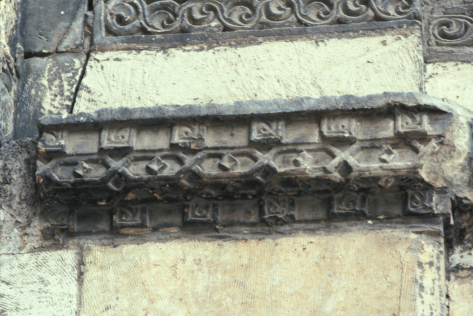
Figure 87. Lower cornice.
Table of Contents
The geometric borders of the carved stone ornament of the Mosque of al-Ḥākim are not nearly as complex as the foliate borders.
Among the border patterns of the mosque are several variations on a simple intertwining of two bands.
Creswell (p. 96) wrote that two moldings at the top of the fifth and sixth registers of the western minaret are “decorated with the same ornament as the lower edge of the entablature of the main entrance”, which is inaccurate, as it ignores the fillings in the lozenges there.141 His drawings show errors in the intertwinings of both patterns, which are 13 cm. high and composed of grooved bands intertwining to form hexagonal lozenges. I do not trust the accuracy of these drawings.
 Figure 87. Lower cornice. |
The lower cornice of the main entrance, described briefly above in “The Middle Register of the Lower Cornice of the Main Entrance”, is, as I wrote, composed of three horizontal registers with short plain bands above and below. The second register, counting from the bottom up, projects from the first, carrying on its face and underside bands of equal width containing thin rounded bands interlaced to form hexagonal lozenges. These lozenges are filled with small projecting square blocks set on the diagonal and enlivened by what appear to be pyramidal depressions, an interesting variation on pyramidal projections. Creswell's drawing, fig. 24, a, shows them intertwining regularly; I am not so sure from the material I have to hand that they are.
According to Creswell's drawing (Muslim Architecture of Egypt, v. 1, fig. 38) the band at the top of the thirteenth register of the western minaret is composed of two thin bands intertwining to produce hexagonal lozenges and quadrilobed figures, though in no regular sequence. His photograph (pl. 32, d) shows a heavily damaged part of the band, but it is undeniably not a regular sequence of lozenges and quadrilobes. Either the design is more complex than has been (or can be, from the single available photograph) understood, or it has been executed irregularly. If the latter, the most likely intended design would seem to be a regular alternation of hexagonal lozenges and quadrilobes formed by bands intertwined regularly (as Creswell's drawing shows; but if the drawing is not a reconstruction of the section shown in the photograph, how was it created?).
Creswell did not illustrate the band at the top of the fifteenth register in a drawing, but it can be seen in his plate 32, b, below the Samarraesque frieze of the sixteenth register. The pattern seems to be the same as that of the band at the top of the thirteenth register (see above, “The Band of the Thirteenth Register of the Western Minaret”) with the long sides of the hexagonal lozenges made somewhat concave and the quadrilobed figures either omitted or rendered loosely. There is no clear alternation of elements, and the vertical joints of the slabs have been adjusted so as to fall on centers of the loosely rendered quadrilobes.
The molding at the top of the eleventh register is, according to Creswell's drawing (fig. 38), 15 cm. high measured across its raking surface, and composed of a pair of grooved bands intertwining to form round-ended lozenges alternating regularly with circles; this would be a variant of the basic form of the borders described above (composed of hexagonal lozenges and quadrilobes) were the elements of those borders alternated regularly.
[Links: Entrance to niched room, Creswell Archive, negative EA.CA.3143 and EA.CA.3145; vault of niched room, EA.CA.3147; ceiling of niched room, EA.CA.3149.]
Both above the entrance to the niched room and around the edge of the ceiling (where it turns the corners as pointed ovals) the pattern of the band at the top of the eleventh register, just discussed, appears (Creswell's fig. 41). I believe the intertwining is regular; over the entrance there is no change in chirality at the top of the arch, where it is possible that something other than a circle was carved.
Creswell did not illustrate the band at the top of the fourteenth register in a drawing either; he called it “somewhat similar” to that of the thirteenth (see “The Band of the Thirteenth Register of the Western Minaret”).142 It can be seen in his plate, 32, b, at the bottom. The pattern appears to be related not to that of the thirteenth register (which his drawing shows as mostly angular, alternating hexagonal lozenges with quadrilobes), but to that of the band at the top of the eleventh register and of the niched room, discussed immediately above. Like the band at the top of the fifteenth register (see “The Band of the Fifteenth Register of the Western Minaret”), the longer elements, here rounded lozenges, have been squeezed in the middle of the long sides to make them somewhat concave—but only on the left of the section shown in the photograph; in the slab on the right (the design is broken at the vertical axis of one of the circles, and the two halves of it do not seem well matched) the lozenges have straight long sides. In the section with concave lozenges the intervening circles are omitted.
[Link: Border of socle, southeast side, Creswell Archive, negative EA.CA.3125 (Creswell, Muslim Architecture of Egypt, v. 1, pl. 24, c).]
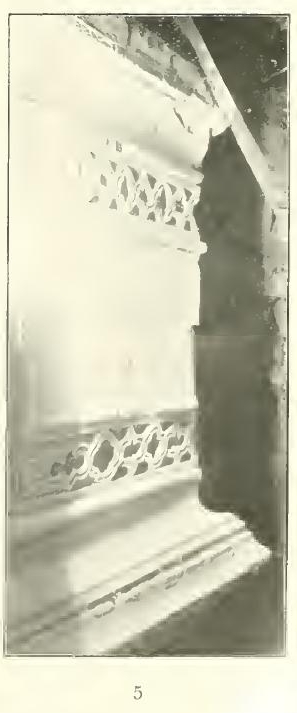 Figure 88. Socle, southeast side; Flury, Ornamente, pl. 24, 5 (cf. Creswell, Muslim Architecture of Egypt, v. 1, pl. 24, c). | 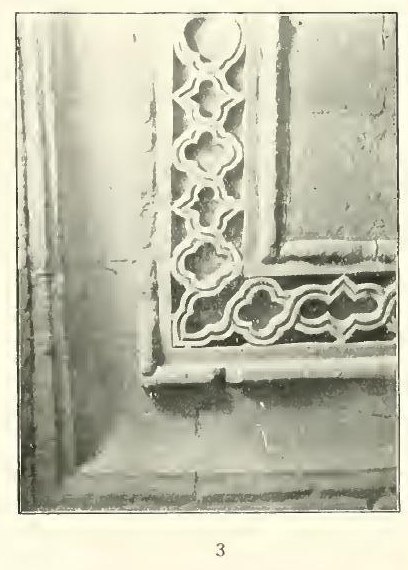 Figure 89. Socle, southeast side; Flury, Ornamente, pl. 25, 3. |
Creswell called the square base of the northern minaret its “socle”, following Flury (Sockel).143 Both Creswell and Flury published photographs of the same section of it (displaying the same chips, cracks, and variations in the decoration), in which the border that runs along both the top and the bottom turns at the left to run vertically to avoid dead-ending into the exterior wall of the mosque (later removed). According to Flury his photograph is of the northeast side, according to Creswell the southeast side.144 Creswell's fuller photograph shows that the decorated section is not long enough to be the southwest side, the other side on which the border turns vertically, so it must be the southeast side. (Flury gave a different orientation because he thought of the minarets as being on the north and south.)
Creswell described the border design, which is framed by thick moldings on both sides, as being 22 cm. wide, composed of “interlacing bands which form quatrefoils, four-pointed stars, &c.”145 It is executed quite irregularly in the photographed section (Creswell's elevation, fig. 36, also shows irregularities). The idea seems to have been to intertwine two flat grooved bands, alternately forming four-lobed figures of equal height and width and round-ended lozenges with short right-angled points protruding from top and bottom in the center. These lozenges, though, have often been compressed lengthwise so that they are the same height and width. At the two corners shown in the photographs only one band continues around the angle, making an open, lobed outline, pointed in the bottom corner and round-ended in the top corner; this is a particularly unimaginative solution.
[Link: Southeastern rotated square, Creswell Archive, negative EA.CA.1356 (Creswell, Muslim Architecture of Egypt, v. 1, pl. 31, a).]
The border of the southeastern rotated square of the main entrance has perhaps survived sufficiently to include in this set of borders (see “Rotated Squares in the Main Entrance” for a discussion of its state of preservation and in particular the Bulletin of the Comité de Conservation des Monuments de la Art Arabe for 1907, pl. 2).
It appears to be formed of two thin bands within two thicker bands that define the frame of the border. The thinner bands intertwine to form hexagonal lozenges alternating with much smaller hexagonal lozenges wider across the width of the frame than along its length. At the corners the intertwining bands form circles around a small plain central disc.
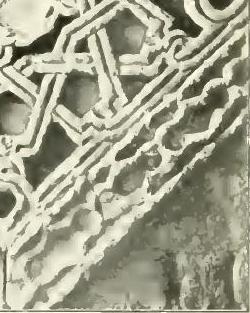 Figure 90. Rotated square in northwest face of sixth register of western minaret |
One of the rotated squares of the western minaret, on the northwest face of the square section (“Northwest Side”), has a border that, from Flury's photograph (detail above) may have been constructed from two thin interlacing bands between two thin bands defining the frame of the border; the interlacing bands form lozenges with round ends and angular centers, as on the socle of the northern minaret.
I consider the register above the raked palmette frieze in the upper border of the main entrance (see “The Band of Repeated Palmettes of the Main Entrance”) as part of the upper cornice.
The design of this register, which does not seem to have been restored, is executed inconsistently. Between two rounded bands a pair of rounded bands intertwines to form lozenges and eight-pointed stars, alternately. However, the apparently intertwining bands actually loop around the apparent border bands at the top and bottom center of each lozenge (these loops are sometimes omitted), and simply join and overlie (or become) the borders at the top and bottom points of the eight-pointed stars. This is the arrangement shown in Creswell's fig. 24, a, which restores most of the register in question in the stretch of it shown; that drawing also shows two lozenges between each eight-pointed star, which disposition occurs in some stretches and not others.
I shall not try to establish what the interlacing of the original ideal pattern would have been (had it been composed only of lozenges they would have been formed from twisted rings), but note that the involvement of the apparently intertwining bands with the border is similar to the arrangement of the main entrance frieze below it.
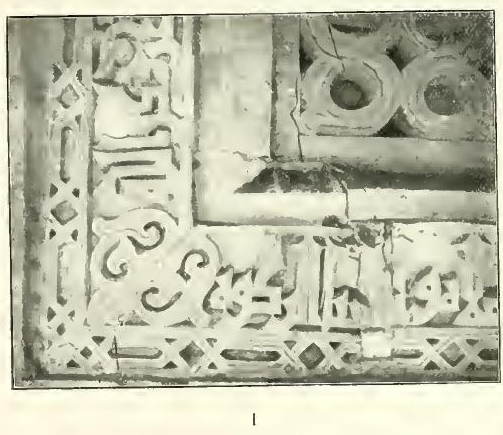 Figure 91. Third register, window facing east; Flury, Ornamente, pl. 25, 1. |
According to Creswell the window facing east in the third register of the northern minaret has a border of “interlacing lines”. He added that only the lower part of the “grille” (screen) of the window is preserved, but that it resembles that of the window facing north (for which see Muslim Architecture of Egypt, v. 1, pl. 24, a). I have not found a photograph that matches this description as I read it, but Flury's pl. 25, 1, which he placed among this set of windows, matches the description of the border of interlacing lines; the bottom of the field appears to resemble that of the window facing north in the same register (for which see “The Screen of the Window Facing North”). Flury described it as facing north and wrote that the interlacing bands of the outer frame were colored blue on a red ground (suggesting that the bands were not painted so as to indicate any intertwining or interlacing). Creswell identified Flury's middle window (pl. 26, 1) as the northern one; once again the two men differed on the description of orientation.
The interlacing lines are actually narrow bands. Flury's photograph is just clear enough to see that they are grooved. Two bands appear to run continuously along the two sides of the border. Between these two bands two other bands seem to intertwine to create lozenge-shaped compartments, the long sides of which run within and along the outer two bands, alternating with squares set diagonally, the outer corners of which either overlap, underlap, or merge with the two outer bands. At the only corner illustrated some other arrangement, which I do not understand clearly, was made. 146
The salient characteristics of the geometric borders are:
There are few repeated patterns.
Most of the borders are simple intertwinings of two bands, producing lozenges, angular or curved, or lozenges alternating with centralized elements such as circles or quadrilobes.
Several borders (around the ceiling of the niched room in the western minaret on the socle of the northern minaret, in the border of one of the rotated squares on the main entrance, and in the upper register of the upper cornice of the main entrance) are composed of alternating long and short elements.
The elaboration of lozenges in the main entrance frieze lower cornice with small square blocks and the complexity of the upper register of the upper cornice (not to mention the detailed dentils) indicate that their designer took special care with the details of this most prominent part of the mosque's exterior.
The border of the socle of the northern minaret is executed quite irregularly, for no obvious reason. The irregularity is significant because it was very visible, being so close to the ground. If such irregularity was tolerated here then it is not surprising that there are so many irregularities in other ornament. The border at the top of the fourteenth register of the western minaret is also executed quite irregularly, especially for a simple pattern that should repeat strictly.
The vertical joints of the slabs on which the borders are carved are often arranged so as to fall on vertical axes of elements of the design.
141. Muslim Architecture of Egypt, v. 1, p. 96, illustrated in fig. 37, “moulding 5” and “moulding 6”.
142. Ibid., p. 99.
143. Ibid., p. 90; Flury, op. cit., p. 44.
144. Flury, op. cit., p. 43; Creswell, op. cit., v. 1, caption to pl. 24, c.
145. Op. cit., v. 1, pp. 91–92.
146. Cf. Herzfeld, Wandschmuck, fig. 230, orn. 217 (the border is not shown in the photograph on pl. 70) and fig. 259, orn. 240.